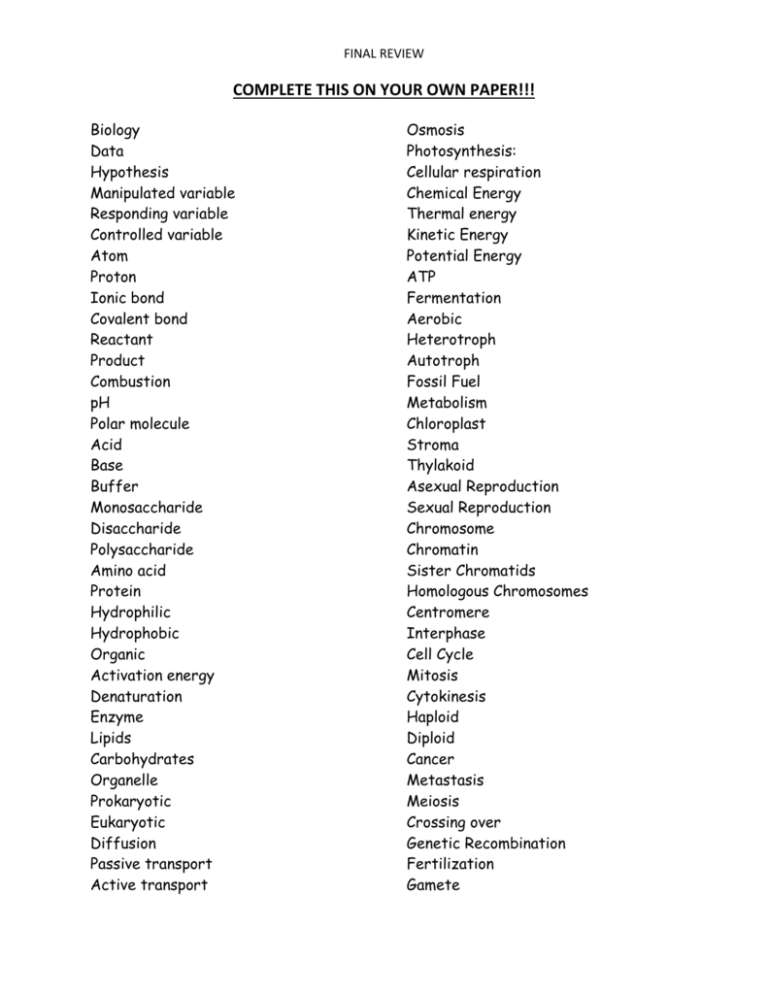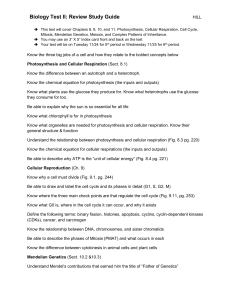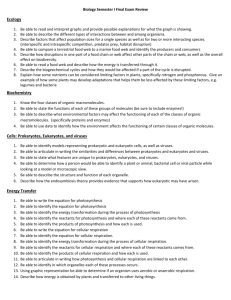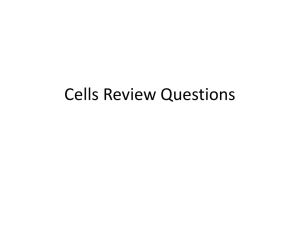FINAL REVIEW answers
advertisement

FINAL REVIEW COMPLETE THIS ON YOUR OWN PAPER!!! Biology Data Hypothesis Manipulated variable Responding variable Controlled variable Atom Proton Ionic bond Covalent bond Reactant Product Combustion pH Polar molecule Acid Base Buffer Monosaccharide Disaccharide Polysaccharide Amino acid Protein Hydrophilic Hydrophobic Organic Activation energy Denaturation Enzyme Lipids Carbohydrates Organelle Prokaryotic Eukaryotic Diffusion Passive transport Active transport Osmosis Photosynthesis: Cellular respiration Chemical Energy Thermal energy Kinetic Energy Potential Energy ATP Fermentation Aerobic Heterotroph Autotroph Fossil Fuel Metabolism Chloroplast Stroma Thylakoid Asexual Reproduction Sexual Reproduction Chromosome Chromatin Sister Chromatids Homologous Chromosomes Centromere Interphase Cell Cycle Mitosis Cytokinesis Haploid Diploid Cancer Metastasis Meiosis Crossing over Genetic Recombination Fertilization Gamete COMPLETE THIS ON YOUR OWN PAPER!!! Practice Problems (#1-3_) Identify the manipulated, and responding variable in the question and use the variables to write an; if, then, because hypothesis. 1. Which Oreo cookie filling does a class of high school students like the best; chocolate, vanilla, or peanut butter? MV: Cookie Filling RV: Like the best Hypothesis: 2. Will food coloring spread faster in a beaker of cold or hot water? MV: temp of water RV: speed of spreading Hypothesis: 3. Will drinking either soda, Gatorade, or water make the runner faster? MV: type of drink RV: speed of runner Hypothesis: 4. Write the steps of the scientific method a. Question b. Hypothesis c. Materials d. Procedures e. Data f. conclusion 5. Define Biology- Study of Life 6. Describe an atom and where the main parts are found a. Proton- Nucleus b. Neutron- Nucleus c. Electron- surrounding 7. What parts are found in the nucleus of an atom? a. Protons and Neutrons 8. What happens to the atoms in chemical reactions? (Are they moved, destroyed, rearranged, created?) a. They are rearranged 9. Describe the difference between covalent and ionic bonds a. Covalent- shares electrons b. Ionic- Transfers electrons 10. Draw the pH scale and place an example of an acid, base, and buffer in the correct location. a. 1-6 acid b. 7 neutral c. 8-14 base 11. Give the chemical make-up of water- H2O 12. Describe what makes water polar and why this is importanta. Hydrogen is + and oxygen is - this leads to cohesion and adhesion 13. Explain why ice floatsa. it is less dense than the liquid form COMPLETE THIS ON YOUR OWN PAPER!!! 14. Describe the difference between a product and reactant a. Reactant: The starting materials in a chemical reaction b. Product: the ending materials in a chemical reaction 15. Explain what an Ion is and what causes a positive and negative ion a. Positive ion- loses an electron b. Negative ion- gains an electron 16. Explain what part of an atom is involved in bonding and how a bonding pair is chosen. a. electrons 17. Complete the table by filling in the missing lines Polymer Starch protein Nucleic acid Monomer glucose Amino acid nucleotide 18. Give an example of: a. Monosaccharide: single sugar b. Disaccharide: two sugar c. Polysaccharide: a chain of sugars 19. Describe activation energy a. The amount of energy needed to start a reaction 20. List four characteristics of enzymes. a. Enzymes are proteins b. Enzymes speed up reactions c. Enzymes lower activation energy d. Enzymes can be denatured 21. Describe two ways a protein could be denatured and give an example. a. pH b. Temperature i. A cooked egg 22. State how many bonds carbon can form and draw a picture of carbon chain with three carbons. a. A carbon forms 4 bonds 23. Define lipids. a. A hydrophobic or water avoiding molecule COMPLETE THIS ON YOUR OWN PAPER!!! 24. Describe the pH scale – use a drawing and label acid, base, neutral and use numbers on the scale. 1 Acid H+ Lemon Juice 7 Neutral blood 25. What ion is in a higher concentration is an acid? a. H+ 26. What ion is in a higher concentration is a base? a. OH27. Draw an atom and label. e(Electron) Proton (+) Neutron (=) 28. Name the main energy source for cells. a. Glucose Base 14 OHBleach COMPLETE THIS ON YOUR OWN PAPER!!! Temp Celsius 15 20 25 30 35 40 Enzyme activity – mm gas 2 5 15 32 22 5 Enzyme Activity 29. Graph the data Temperature 30. What is the optimum temperature for this enzyme to work? a. 30 degrees 31. Using your graph predict the amount of gas formed at 22.5 degrees. a. ~12 mm gas 32. What is the temperature range of this data? a. 15 to 40 degrees 33. Describe the trend of the enzyme activity. a. The enzyme works the best between 25 and 35 34. Give a scientific reason to explain the trend. a. The enzyme works best between 25 and 35 degrees because outside of that temperature it becomes denatured 35. State the Function or job of the following cell organelles: Nucleus: Holds the cell’s DNA Chloroplast: Does Photosynthesis Cytoplasm: Filler of the cell, helps maintain shape Mitochondria: Does Cellular Respiration Endoplasmic Reticulum: Creates cell parts Golgi Apparatus: Packages cells parts Lysosome: breaks down macromolecules Ribosome: Makes proteins from DNA Plasma Membrane (cell membrane): Protects and regulates flow of materials 36. Give the differences between a prokaryote and eukaryote. a. Prokaryote- A cell lacking a nucleus b. Eukaryote- A cell containing a nucleus 37. What organelle makes a plant leaf look green? COMPLETE THIS ON YOUR OWN PAPER!!! a. The chloroplast 38. Which organelle provides cell energy? a. Mitochondria 39. State two differences between a plant and animal cell a. A plant cell contains a chloroplast and cell wall 40. Draw and label a plasma membrane (cell membrane) Phosphate: Hydrophilic (water loving) Lipid: Hydrophobic (water avoiding) 41. What are the uses of a plasma membrane protein? a. Transportation (channel or tunnel in membrane) b. Communication c. Enzyme activity 42. Define diffusion and osmosis a. Diffusion: The movement of particles from high concentration to low concentration b. Osmosis: The movement of water from high concentration to low concentration 43. Give the difference(s) between diffusion and osmosis a. Osmosis is specific to water, diffusion is other particles 44. Describe the difference between passive and active transport: a. Passive transport doesn’t use energy b. Active transport uses energy and goes against the concentration gradient 45. If the concentration of particles is the same on each side of the membrane, do they stop moving? a. No, Particles never stop moving, if they are at equilibrium an equal number will move from each side 46. Which organelle breaks down macromolecules? a. Lysosome 47. What does a membrane protein do? a. See # 41 48. What is the function of a cell wall? a. Maintains a plant cells shape and protection 49. Why is a cell considered a system? a. A cell is considered a system because all the parts (organelles) work together for a common goal COMPLETE THIS ON YOUR OWN PAPER!!! 50. Explain what happens to a red blood cell when put in salt water and why? a. The cell will shrink because the water will move out of the cell towards the salt, due to osmosis. 51. Explain what happens to a red blood cell when put into pure water and why? a. The cell will expand because the water will move into the cell towards the particles in the blood cell, due to osmosis 52. Explain the difference between an autotroph and heterotroph a. Autotroph: an organism that can make its own food (plants) b. Heterotroph: An organism that must get is food from another source. (animals) 53. Give the equation for cellular respiration. a. C6H12O6 + 6O2 -> 6CO2 + 6H2O + 38 ATP 54. Give the equation for photosynthesis. a. Sunlight + 6CO2 + 6H2O -> C6H12O6 + 6O2 55. What gas does a plant give off? a. Oxygen 56. What are the inputs (reactants) and outputs (products) of a cell in cellular respiration? a. Reactants: sugar (C6H12O6) and Oxygen (O2) b. Products: Carbon Dioxide, Water, and ATP (6CO2 + 6H2O + 38 ATP) 57. Explain why cellular respiration and photosynthesis are almost opposite processes a. What goes into cellular respiration is what comes out of photosynthesis and what goes into photosynthesis comes out of cellular respiration. The equations are opposite. 58. How is the burning of fossil fuel the same as cellular respiration? a. They both take a large carbon based molecule (Sugar or Gasoline) and break them down in to smaller pieces and energy 59. What process causes muscle soreness? a. Lactic Acid fermentation 60. Why is cellular respiration an aerobic process? a. It requires oxygen 61. What are the reactants and products of photosynthesis? a. Reactants: Sunlight, Carbon Dioxide, and Water (Sunlight + 6CO2 + 6H2O ) b. Products: Sugar and Oxygen (C6H12O6 + 6O2 ) 62. Why do we see plants as green? a. Because the chloroplast reflects green light 63. What parts of the visible spectrum do plants absorb and reflect? a. The plant absorbs all of the visible spectrum but green light COMPLETE THIS ON YOUR OWN PAPER!!! b. The plant reflects green light 64. What is the major difference in Cytokinesis between plants and animals? a. Plant cells must make a cell plate to create a cell wall before they can complete cytokinesis. Animal cells can just pinch apart. 65. What are the differences between benign and malignant tumors? a. Begnin: a mass of or normal cells b. Malignant: A mass of abnormal (cancer) cells that can spread 66. What causes cancer cells? a. A sever disruption of the cell cycle. The cell misses the checkpoints in G1 and G2. 67. What is the outcome of Mitosis? a. 2 genetically identical diploid daughter cells 68. What is the outcome of Meiosis? a. 4 genetically different haploid daughter cells 69. Why is crossing over important? a. It creates genetic diversity ( so you’re not identical to you parents) 70. What type of cell is haploid and what type of cell is diploid? a. Haploid- meiosis cell (gamete) b. Diploid- Mitosis cell 71. Define gamete a. A haploid sex cell 72. What type of cell division creates a gamete? a. Meiosis 73. Make the below T-chart on your paper to show the major differences between Mitosis and Meiosis Mitosis Meiosis 2 cells 4 cells Identical DNA Different DNA No crossing over Crossing over 1 stage 2 stages Diploid Haploid COMPLETE THIS ON YOUR OWN PAPER!!! 74. Draw the below diagram on your paper and identify A, B C Centromere Sister Chromatids







